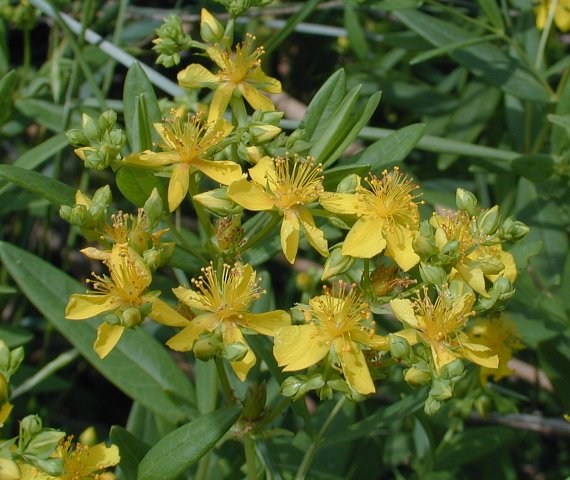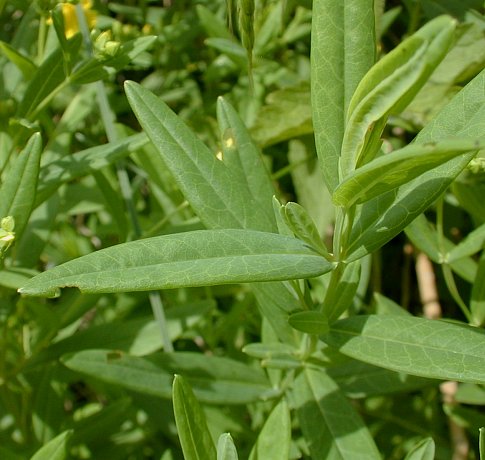Description: This perennial plant is up to 2½' tall, branching frequently from the upper axils of the leaves, and having a shrubby appearance. The base of the plant is occasionally semi-woody, but the upper stems are herbaceous and green. The entire plant is devoid of hairs. The opposite leaves are up to 3" long and ¾" across. The pairs of leaves rotate by 90° as they ascend the stems. They are oblong or lanceolate with blunt tips, and are sessile against the stems. The margins are smooth, while the underside of each leaf is light green and devoid of black dots.

Numerous clusters
of yellow flowers occur at the ends of the upper stems. Each flower is
about ½–¾" across, with 5 rounded petals, and numerous long stamens
surrounding a stigma that is slender and flask-shaped. The flowers have
a mild buttercup-like fragrance. The blooming period occurs from early
to mid-summer and lasts about a month. The small seeds are distributed
to some extent by the wind. The root system consists of a central
taproot and short rhizomes. This plant tends to spread vegetatively in
sunny open areas.
Cultivation:
The preference is full or partial sun, and average to dry conditions.
Different kinds of soil are readily tolerated, including those with
substantial amounts of loam, gravel, sand, or clay. However, poor soil
is often preferred because of the reduced competition from taller
plants.

Range &
Habitat:
Round-Fruited St. John's Wort is widely distributed in Illinois, but
it occurs only occasionally (see Distribution
Map). It is least common in SE Illinois. This is a native
wildflower. Habitats include
mesic to dry gravel prairies, sand prairies, hill prairies, rocky open
woodlands, thickets, scrubby barrens, rocky bluffs overlooking major
rivers, limestone glades, dry banks of lakes, and open areas along
roadsides.
Faunal Associations:
Bumblebees and other long-tongued bees are probably the most important
pollinators of the flowers. Other visitors include Halictine bees,
beetles, and Syrphid flies, but they are less effective at pollination.
All of these insects collect or feed on the abundant pollen, because
the flowers offer no nectar. The caterpillars of the butterfly Strymon
melinus (Gray Hairstreak) reportedly eat the seed capsules,
although it is not a preferred host plant. The caterpillars of the moth
Nedra ramosula (Gray Half-Spot) feed on the
foliage. Like other St. John's Worts, the foliage of this species
contains a toxic chemical that causes photosensitive skin reactions,
particularly in light-skinned animals, and can irritate the
gastrointestinal tract. Therefore, mammalian herbivores usually leave
this plant alone if other food sources are available.

Photographic
Location:
The photographs were taken at Crystal Lake Park in Urbana, Illinois.
Comments:
This plant can be easily distinguished from similar St. John's Worts by
the absence of black dots on the flower petals and undersides of the
leaves. The flowers tends to be larger than Hypericum
punctatum (Spotted St. John's Wort), but smaller than Hypericum
kalmii (Kalm's St. John's Wort), and Hypericum
pyramidatum (Great S. John' Wort). This is an attractive
plant while in the early to middle stages of bloom, although later
losses some of its appeal because of the persistance of older brown
petals near the seed capsules.